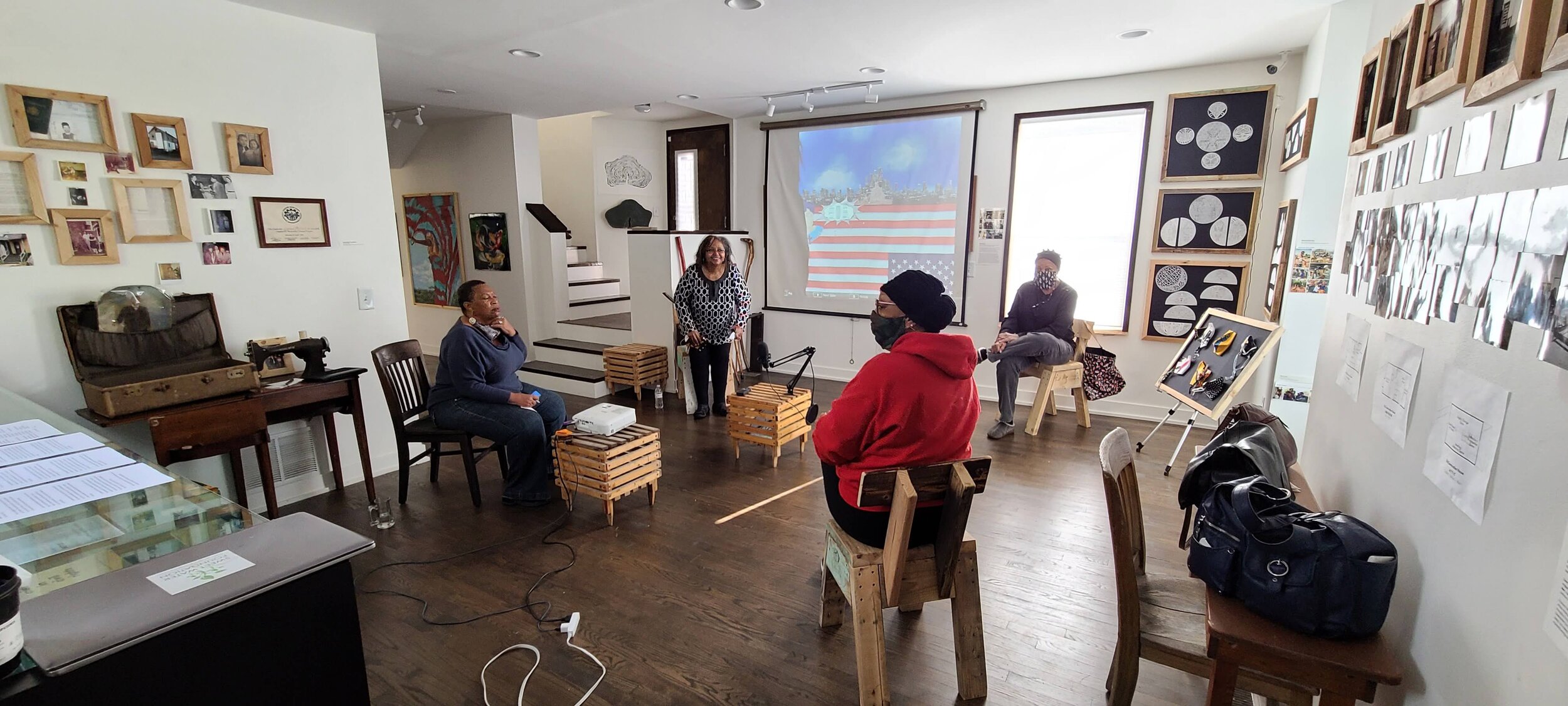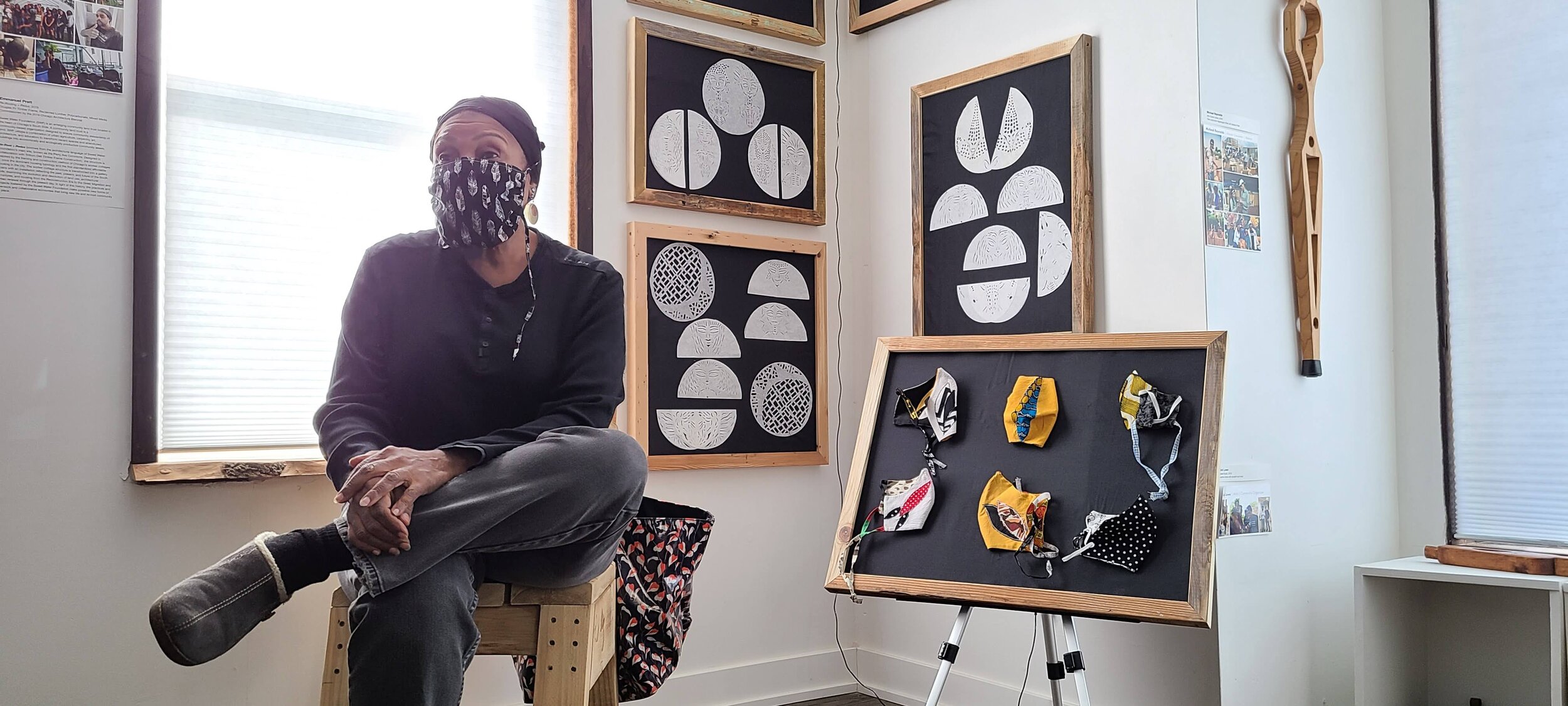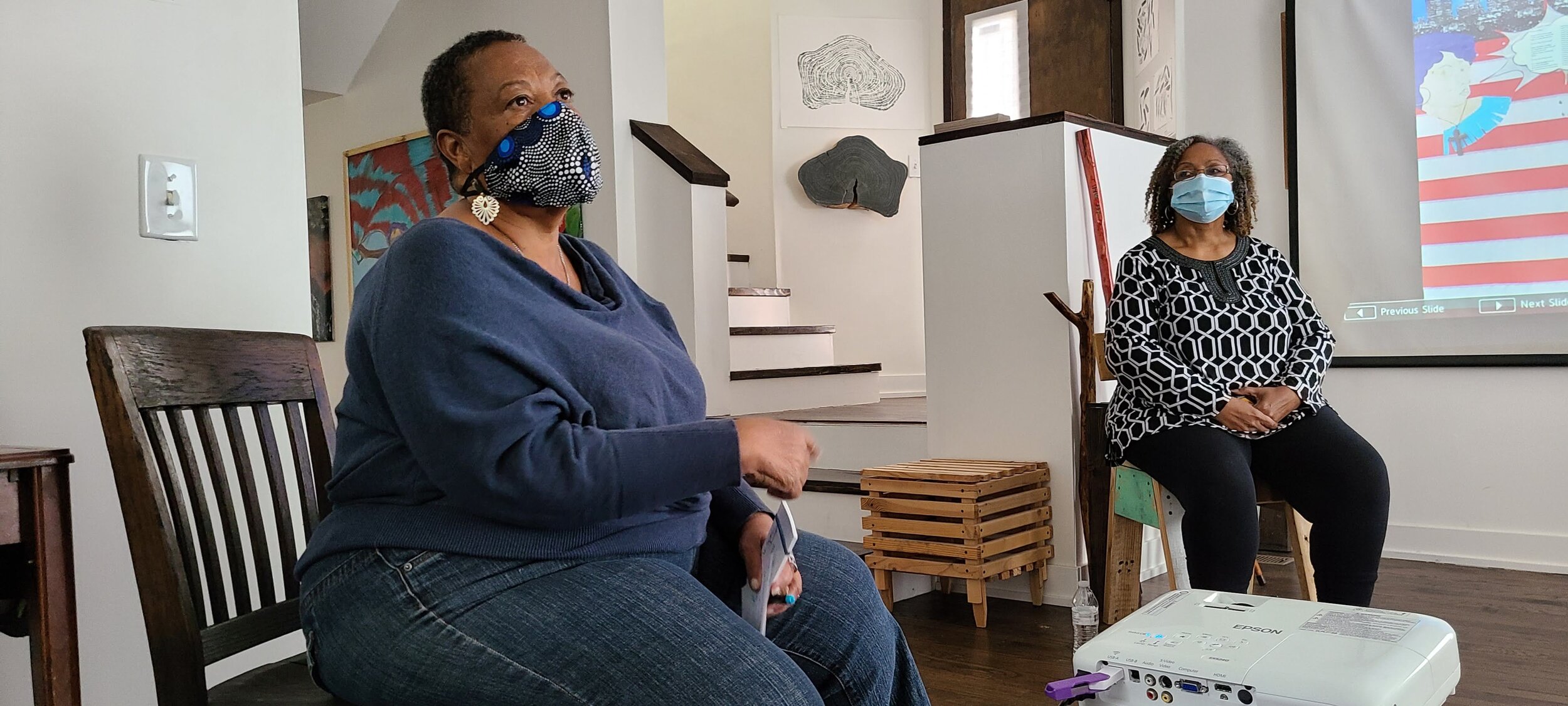Artists’ Conversation in Gallery at [Re]Construction House
Late last fall, artists Ricardia Davis, Arzula Gardner, and Rhonda Long, all from Chicago, joined New Orleans native, Amy Stelly, to discuss everything from memories to mates. The conversation fostered the true mission of the [Re]Construction House: public engagement. Ricardia, Rhonda, and Amy are visual artists; and Arzula is a singer and actor. Collectively, their bodies of work speak to the ethos of the house: spirituality, civil rights, the Black experience, and the tradition of using available materials to create art. We invite you to read Amy Stelly’s reflection of the conversation and her experience in [Re]Construction House.
A Conversation between Ricardia Davis, Arzula Gardner, Rhonda Long , and SWF Human-in-Residence, Amy Stelly
November 19, 2020
Written by Amy Stelly
The significance of the [Re]Construction House at The Commonwealth grabs you little by little. The totality of its relevance did not hit me until I returned to New Orleans and wrote about my home. I realized that my house and the [Re]Construction House are kindred spirits. Both are community houses. They welcome a variety of visitors; present artifacts that embody their histories and provide places for discourse and comfort. Both trigger memories and invite you to reminisce. Both are more than a century old. And both are, as the [Re]Construction House is so aptly described, “a cultural mesh of artistic philosophy.”
The [Re]Construction House was designed through a process of deconstruction and re-imagination with the intent of engaging community. Through this process, the house was reborn as art. Stories are visible in the reclaimed trees, salvaged wood, and discarded plastics that have been beautifully transformed into functional pieces of art. Everything is bespoke - even the windows are works of art.
When you enter the [Re]Construction House, you quickly discern that its residents fought for the greater good. Their struggles and achievements are revealed. The house’s artifacts and treasures clearly illuminate its place in Chicago’s history. The stories speak to the common dreams and values that we as a Black community — regardless of where we’re from — hold dear. More importantly, they highlight the themes of Sweet Water’s conversations. So, it stands to reason that this place of commoning and beauty would be a space for four seemingly dissimilar artists to gather.
On October 28, 2020, artists Ricardia Davis, Arzula Gardner, and Rhonda Long, all from Chicago, joined me to discuss everything from memories to mates. Our conversation fostered the true mission of the [Re]Construction House: public engagement. Ricardia, Rhonda, and I are visual artists; and Arzula is a singer and actor. Collectively, our bodies of work speak to the ethos of the house: spirituality, civil rights, the Black experience, and the tradition of using available materials to create art.
Ricardia’s and Rhonda’s works are on exhibit at the [Re]Construction House. They exemplify Sweet Water’s robust conversations. Human actions are the ties that bind the pieces and make the conversations tangible. Ricardia’s series of intricate, coffee filter paper cuttings, Unintentional Intentions (2020), speak to memory and ethnicity. The intricacy of her cuttings is reminiscent of lace — fragile yet strong. The patchwork strategy seen in her COVID face coverings was born out of a need to assemble enough fabric to make one mask. Rhonda’s collection of paintings, Imagining Water, celebrate water and the interplay of man and space. She uses resin to illustrate the clarity of water in Koi (2019) and evokes the darkness of an underwater cave in Water’s Edge (2016), a mixed-media triptych.
All four of us came of age as baby boomers. We are Black in America. But each of us has a unique way of expressing human experiences in our explorations of the body, memory and ethnicity. Equally as revealing was our desire to have history or regionalism serve as foundations for identity, or for identity as an artist and creator to supersede identity through race.
Ricardia identifies as a Foundational Black American, an American-born Black person descended from Africans forced over to America via slavery and used to build this country. My framework for identity accounts for the influences of French and Creole cultures that can still be experienced in New Orleans today. Rhonda prefers to be identified as an artist who happens to be Black. Arzula’s point of view is historically steeped in the evolution of monikers for Black Americans as a race, citing that we’ve moved from Colored to Negro to Black to African American. But her preference to identify as Black came about with the rise of Barack Obama, who was truly of African and American descent. Like many, she realized that Obama authentically defined African American in a way that most cannot.
We all agreed that the role and portrayal of the Black body and Black hair are vital to expressions of identity in art. Our approaches run the gamut of our creative practices. Arzula uses her body in service to art. Her ever-changing hair allows her to become different characters. She expresses form and experience through sound and movement. Her work is dependent on her body. She uses her form in its entirety to interpret the visions of others. She’s both vessel and subject.
I also use my body in service to art. I have authored self-portraits and begun using selfie videos to give expression to my poetry and other statements of creative disruption. Typically, I express the human form through line drawings, collage, or sculpturally — built out as masks, flip-toys, or mermaids. My characters’ experiences are often described through words or illustrated in constructed environments, as in God Bless America (2019-20), an assemblage that was projected in the gallery during our conversation.
Ricardia renders the human form through delicate paper cuttings whose power lies in the subtraction of material. She realizes them through cuts that evoke hip hop fashion or tribal scars. Her figures are adorned. She articulates the male figure through a form she calls a “basic street physique.” But the detailing makes each one unique. Her figures are ethnic but transcend ethnicity. They are animal yet human. Faces are illustrated as masks, a study that is expanded in her COVID face coverings.
Rhonda has a passion for the human image. She realistically portrays the “lumps and bumps” of the Black body, defying conventional beauty. Her paintings present exquisitely rendered figures with beautiful skin tones that show the diversity of the Black race. Their experiences with the elements are tactile. You can feel the softness of a warm, tropical breeze in Into the Wind (2012), an oil on canvas; the cool, thirst-quenching freshness of water in her giclee, Living Waters (2008); or the wetness of water in Bathing Boy (2016), an acrylic on canvas.
The human experiences of Rhonda’s characters evoke memories that are common and easy to vocalize. She constructs her work from dreams. She vividly sees figure, action and place. Ricardia’s faces are visions, tributes to her memory of seeing them everywhere and in everything. Arzula draws from the memory of her experiences to enrich her performances. And my work asks you to remember through the use of the written word, familiar images, or reclaimed materials and reconstruction, another shared theme in our work. Rhonda reworks her canvases. She often paints with oils over acrylics. Arzula takes music apart and presents it in another way, respecting the original without copying. And Ricardia repurposes materials to create images that have their own dialect and speak with a unique vocabulary.
Each of us remains steadfast in our authenticity while remaining critical links for others as they journey through life’s villages. We create emotional connections through work that speaks to the power of the spirit. We find inspiration in our mothers, nature, the sciences, fine art, our collaborators, and our friends. We tell our stories in our own way. Ricardia cuts her own people and snowflakes. Rhonda paints her own pictures. Arzula sings her songs the way she wants to sing them. And I write, draw, paint, build, and communicate whatever I want the world to know.
As artists, we were blessed to be able to share thoughts and experiences in a place that feels like home. It was truly kismet. Our conversation fostered a goal of the [Re]Construction House in its exploration of art and society as key components of community and urbanism. Our meeting brought together people and stories that contribute to remembering. We have vowed that our conversations will be continued.




